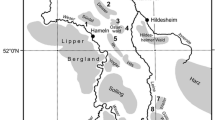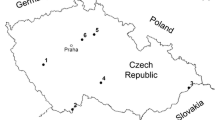Abstract
During storms in 2005, a number of beech trees fell over at Biskopstorp, SW Sweden, offering the opportunity to study epiphytes along entire stems. In total 16 beech trees in four beech stands representing three different age classes were included. For each tree, 2 m segments from the base to the top were surveyed. In total 115 species were found (76 lichens, 39 bryophytes), of which 30 were considered to be of conservation concern (22 lichens, 8 bryophytes). For lichens significantly more species were recorded above 2 m in height, whereas more bryophytes were recorded below 2 m in height. Certain red-listed lichens were recorded only above 2 m in height on old trees. In a second data set from the same area 140 age-determined beech trees were surveyed for species of conservation concern at the heights 0–2 and 2–5 m, respectively. These species were found almost exclusively on old beech trees, and presence at 2–5 m was recorded, with one exception, only on those trees which also had species of conservation concern at 0–2 m. Records of these species correlated significantly to microhabitat variables, i.e. the presence of rough bark and moss cover higher up the stems on the old trees. This study indicates that surveying only the base in really old beech forests can underestimate both the number of species of conservation concern and their population sizes. However, surveys restricted to the base in rather even-aged beech stands catch a large proportion of the trees with species of conservation concern.





Similar content being viewed by others
References
Almborn O (1948) Distribution and ecology of some south Scandinavian lichens. Bot Not 1:1–254
Aptroot A (1997) Lichen biodiversity in Papua New Guinea, with the report of 173 species on one tree. Bibl Lichenol 68:203–213
Arup U, Ekman S, Kärnefelt I, Mattsson J-E (1997) Red-listed lichens and changes in the lichen flora of southwestern Sweden. Lund (in Swedish with an English summary)
Barkman JJ (1958) Phytosociology and ecology of cryptogamic epiphytes. van Gorcum, Assen
Blanco O, Crespo A, Divakar PK, Esslinger TL, Hawksworth DL, Lumbsch HT (2004) Melanelixia and Melanohalea, two new genera segregated from Melanelia (Parmeliaceae) based on molecular and morphological data. Mycol Res 108:873–884. doi:10.1017/S0953756204000723
Coote L, Smith GF, Kelly DL, O’Donoghue S, Dowding P, Iremonger S et al (2008) Epiphytes of Sitka spruce (Picea sitchensis) plantations in Ireland and the effects of open spaces. Biodivers Conserv 17:953–968. doi:10.1007/s10531-007-9302-3
Ellyson WJT, Sillett SC (2003) Epiphyte communities on Sitka spruce in an old-growth redwood forest. Bryologist 106:197–211. doi:10.1639/0007-2745(2003)106[0197:ECOSSI]2.0.CO;2
Fahlvik N (1999) En dendrokronologisk studie över sambandet mellan beståndsålder och förekomsten av rödlistade lavar på bok inom Biskopstorps-området i södra Halland. B.Sc. Thesis. Inst. för sydsvensk skogsvetenskap. SLU, Alnarp
Fritz Ö (2006) Beech Fagus sylvatica forests at Biskopstorp. In: Hurford C, Schneider M (eds) Monitoring nature conservation in cultural habitats, Chap 29. Springer, The Netherlands, pp 309–322
Fritz Ö, Gustafsson L, Larsson K (2008a) Does forest continuity matter in conservation? A study of epiphytic lichens and bryophytes in beech forests of southern Sweden. Biol Conserv 141:655–668
Fritz Ö, Niklasson M, Churski M (2008b) Tree age is a key factor for the conservation of epiphytic lichens and bryophytes in beech forests. Appl Veg Sci (in press)
Gärdenfors U (2000) Hur rödlistas arter? Manual och riktlinjer (How to red-list species. Manual and guidelines). ArtDatabanken, SLU, Uppsala (in Swedish, English summary)
Gärdenfors U (ed) (2005) The 2005 red list of Swedish species. ArtDatabanken, SLU, Uppsala
Hallingbäck T (2007) Working with Swedish cryptogam conservation. Biol Conserv 135:334–340. doi:10.1016/j.biocon.2006.10.020
Hallingbäck T, Hedenäs L, Weibull H (2006) New checklist of Swedish bryophytes. Sven Bot Tidskr 100:96–148 (in Swedish with an English summary)
Hultengren S (1995) The lichen flora on a giant oak in Västergötland, W Sweden. Sven Bot Tidskr 89:165–170 (in Swedish with an English summary)
Jarman SJ, Kantvilas G (1995) Epiphytes on an old Huon pine tree (Lagarostrobos franklinii) in Tasmanian rainforest. NZ J Bot 33:65–78
Johansson T, Knutsson T, Lundkvist H (2003) Epiphytic lichens on old oaks—what hides on 2–14 meters height? Graph Scr 14:49–54 (in Swedish with an English summary)
Lindbladh M, Niklasson M, Karlsson M, Björkman L, Churski M (2008) Close anthropogenic control of Fagus sylvatica establishment and expansion in a Swedish protected landscape—implications for forest history and conservation. J Biogeogr 35:682–697. doi:10.1111/j.1365-2699.2007.01813.x
McCune B (1993) Gradients in epiphyte biomass in three Pseudotsuga-Tsuga forests of different ages in western Oregon and Washington. Bryologist 96:405–411. doi:10.2307/3243870
McCune B et al (1997) Vertical profile of epiphytes in a Pacific northwest old-growth forest. Northwest Sci 71:145–152
Milne J, Louwhoff S (1999) Vertical distribution of bryophytes and lichens on a Myrtle Beech, Nothofagus cunninghamii (Hook.) Oerst. Hikobia 13:23–30
MINITAB (1972–2007) Statistical software. Release 15. Minitab Inc
Niklasson M, Churski M, Fuentes M, Gawron A (2005) Dynamics and structure in the deciduous forests of Biskopstorp landscape, a dendroecological study. Meddelande: 20. In Swedish with an English Summary, Länsstyrelsen, Halland
Nitare J, Hallingbäck T (2005) Indicator species for assessing the nature conservation value of woodland sites—a Flora of selected cryptogams, 3rd edn. Skogsstyrelsens förlag, Jonkoping (in Swedish with an English summary)
Plata ER, Lücking R, Lumbsch HT (2007) When family matters: an analysis of Thelotremataceae (Lichenized Ascomycota: Ostropales) as bioindicators of ecological continuity in tropical forests. Biodivers Conserv . doi:10.1007/s10531-007-9289-9
Raab B, Vedin H (eds) (1995) Climate, lakes and rivers. The national atlas of Sweden. SNA Publishing, Stockholm
Ranius T, Johansson P, Berg N, Niklasson M (2008) The influence of tree age and microhabitat quality on the occurrence of crustose lichens associated with old oaks. J Veg Sci. doi:10.3170/2008-8-18433
Ruchty A, Rosso AL, McCune B (2001) Changes in epiphyte communities as the shrub, Acer circinatum, develops and ages. Bryologist 104:274–281. doi:10.1639/0007-2745(2001)104[0274:CIECAT]2.0.CO;2
Santesson R, Moberg R, Nordin A, Tønsberg T, Vitikainen O (2004) Lichenforming and lichenicolous fungi of Fennoscandia. Museum of Evolution, Uppsala University
Sillett SC, Rambo TR (2000) Vertical distribution of dominant epiphytes in Douglas-Fir forests of the central Oregon cascades. Northwest Sci 74:44–49
Williams CB, Sillett SC (2007) Epiphyte communities on redwood (Sequoia sempervirens) in northwestern California. Bryologist 110:420–452. doi:10.1639/0007-2745(2007)110[420:ECORSS]2.0.CO;2
Will-Wolf S, Geiser LH, Neitlich P, Reis AH (2006) Forest lichen communities and environment—how consistent are relationships across scales? J Veg Sci 17:171–184. doi:10.1658/1100-9233(2006)17[171:FLCAEC]2.0.CO;2
Acknowledgements
Valuable comments on the manuscript have been made by Ulf Arup, Jörg Brunet and Tommy Knutsson. Vikki Bengtsson has made linguistic corrections and Nils Fahlvik has provided data from cored beech trees. The study is part of the research programme “Sustainable Management of Hardwood Forests” at the Swedish University of Agricultural Sciences.
Author information
Authors and Affiliations
Corresponding author
Rights and permissions
About this article
Cite this article
Fritz, Ö. Vertical distribution of epiphytic bryophytes and lichens emphasizes the importance of old beeches in conservation. Biodivers Conserv 18, 289–304 (2009). https://doi.org/10.1007/s10531-008-9483-4
Received:
Accepted:
Published:
Issue Date:
DOI: https://doi.org/10.1007/s10531-008-9483-4




